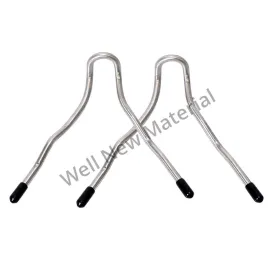Jun. 13, 2024
Refractory anchors play a critical role in the construction and maintenance of high-temperature industrial furnaces, kilns, and reactors. These components are essential for securing refractory linings, which protect the structural shell from extreme heat and chemical attack. This article provides a comprehensive overview of refractory anchors, their types, applications, and benefits, ensuring that industry professionals and enthusiasts alike gain a clear understanding of their importance.
What Are Refractory Anchors?
Refractory anchors are metallic or ceramic components used to secure refractory linings to the interior surfaces of high-temperature vessels. These anchors help maintain the structural integrity of the lining by holding it in place, preventing it from peeling away or collapsing under extreme conditions. Refractory anchors come in various shapes and sizes, tailored to different applications and lining materials.

Types of Refractory Anchors
Refractory anchors are available in several types, each designed to meet specific requirements:
Y-Anchors: Shaped like the letter Y, these anchors provide excellent support and are commonly used in dense refractory linings.
V-Anchors: These anchors are V-shaped and are ideal for securing thin, lightweight refractory linings.
U-Anchors: With a U-shaped design, these anchors are versatile and used in various refractory lining applications.
Ceramic Anchors: Made from high-temperature resistant ceramics, these anchors are used in environments where metal anchors would oxidize or corrode.
Materials Used for Refractory Anchors
The choice of material for refractory anchors depends on the operating environment and the type of refractory lining. Common materials include:
Stainless Steel: Offers excellent corrosion resistance and is suitable for most applications.
Inconel: A nickel-chromium alloy known for its high-temperature strength and resistance to oxidation.
Ceramics: Used in extremely high-temperature environments where metals would fail.
Applications of Refractory Anchors
Refractory anchors are used in various high-temperature industrial applications, including:
Petrochemical Plants: Secure linings in reactors, reformers, and furnaces exposed to corrosive gases and extreme heat.
Cement Kilns: Maintain the structural integrity of linings in rotary kilns and other high-temperature processing equipment.
Power Plants: Used in boilers and incinerators to protect against high heat and chemical attack.
Steel Mills: Ensure the durability of linings in blast furnaces, ladles, and other high-temperature steel-making equipment.
How Refractory Anchors Enhance Performance
Related articles:Refractory anchors play a vital role in enhancing the performance and longevity of refractory linings:
Preventing Lining Collapse: Anchors hold the refractory lining in place, preventing it from detaching and collapsing under thermal and mechanical stress.
Minimizing Thermal Expansion Issues: By securing the lining, anchors help accommodate thermal expansion and contraction, reducing the risk of cracks and spalling.
Improving Heat Distribution: Properly anchored linings ensure even heat distribution, enhancing the efficiency and performance of high-temperature equipment.
Considerations for Choosing Refractory Anchors
When selecting refractory anchors, several factors should be considered to ensure optimal performance:
Operating Temperature: Choose anchors made from materials that can withstand the maximum operating temperature of the application.
Chemical Environment: Consider the chemical composition of the gases and materials in contact with the lining to avoid corrosion and degradation of the anchors.
Lining Material: Match the anchor type and material to the refractory lining being used to ensure compatibility and effectiveness.
Installation Method: Ensure that the chosen anchors can be installed correctly and securely, considering the specific requirements of the application.
Installation and Maintenance of Refractory Anchors
Proper installation and maintenance are crucial for the effectiveness of refractory anchors:
Installation: Anchors should be installed at the correct spacing and depth to provide adequate support for the refractory lining. Welding, threading, or other secure methods should be used to attach the anchors firmly to the structural shell.
Inspection: Regular inspections should be carried out to check for signs of wear, corrosion, or damage to the anchors and lining.
Replacement: Damaged or corroded anchors should be replaced promptly to maintain the integrity of the refractory lining and prevent costly downtime.
Benefits of Using Refractory Anchors
The benefits of using refractory anchors in high-temperature applications are numerous:
Enhanced Durability: Refractory anchors significantly increase the lifespan of refractory linings by preventing detachment and collapse.
Improved Safety: Secure linings reduce the risk of catastrophic failure and ensure safe operation of high-temperature equipment.
Cost-Effective: By extending the life of refractory linings and reducing maintenance needs, anchors offer a cost-effective solution for industrial applications.
Conclusion
Refractory anchors are essential components in the construction and maintenance of high-temperature industrial equipment. They play a critical role in securing refractory linings, enhancing their performance, and ensuring the safety and efficiency of operations. Understanding the types, materials, applications, and proper installation of refractory anchors is crucial for optimizing their benefits and achieving long-lasting, reliable performance in demanding industrial environments.
Previous: None
Next: None
Related Articles
If you are interested in sending in a Guest Blogger Submission,welcome to write for us!
All Comments ( 0 )